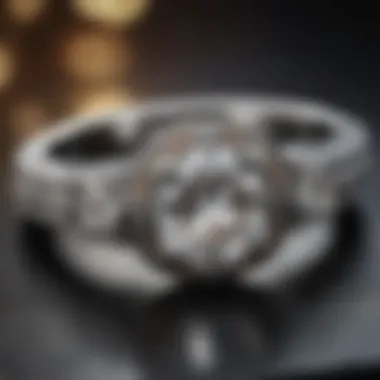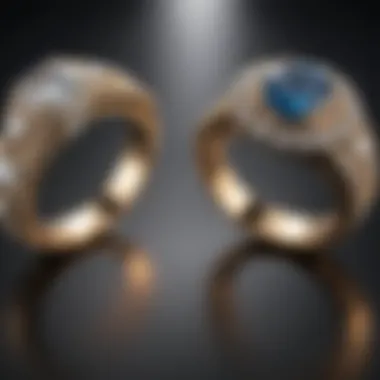Exploring High vs. Low Setting Engagement Rings


Intro
In the world of engagement rings, one of the primary distinctions is the setting, which can dramatically alter both the visual appeal and the functionality of the piece. This article will navigate through the nuances of high and low setting engagement rings, providing clarity that can assist individuals in their decision-making process. High settings exhibit elegance, while low settings often showcase a more understated beauty. Beyond aesthetics, these settings come with distinct practical implications, such as care, durability, and personal expression.
Understanding these factors is crucial for anyone considering an engagement ring. This guide will offer an in-depth look into the various aspects of high and low settings, ensuring the reader is well-equipped to make an informed choice.
Gemstone Overview
Definition of Gemstones
Gemstones are naturally occurring minerals or rocks that hold aesthetic and geological value. They are often cut and polished to enhance their beauty and used in various types of jewelry. Gemstones can be classified into precious and semi-precious categories based on their rarity and desirability.
Classification of Gemstones
- Precious Gemstones: This group includes diamonds, rubies, sapphires, and emeralds. They are typically valued for their rarity, brilliance, and hardness.
- Semi-Precious Gemstones: This category encompasses a wider array of stones such as amethyst, topaz, and garnet. While they may not be as rare as precious gemstones, they can still exhibit significant beauty and character.
Diving deeper into gemstone properties enriches the understanding of what high and low settings can bring. High settings often allow for a larger exposure of the gemstone, showcasing its inherent qualities. In contrast, low settings tend to cradle the stone more, providing durability and emphasizing the ring's design.
Historical Significance
Origins of Gemstone Use
The use of gemstones in jewelry dates back thousands of years. Ancient cultures incorporated them for various reasons, including aesthetics, protection, and status. Historical records show that ancient Egyptians adorned themselves with lapis lazuli and turquoise, while ancient Romans favored sapphires and pearls.
Cultural Insights: Gemstones in Ancient Civilizations
In ancient civilizations, gemstones played significant roles:
- Egyptians: Gemstones were believed to offer protection and were often found in burial artifacts.
- Greeks and Romans: They shaped their belief systems; for instance, the Greeks thought that amethyst could prevent intoxication.
- Indians: Gemstones were often linked to astrology and were believed to govern personal luck.
The profound connection between gemstones and cultural symbolism enriches our understanding of engagement rings and their deeper meanings. Each setting type can resonate differently based on the stone it holds, underscoring the emotional significance inherent in these personal pieces.
"Choosing an engagement ring is not just about a stone; it's about the story and meaning behind it."
Prelims to Engagement Ring Settings
When contemplating the significance of an engagement ring, the setting plays a crucial role in its overall appeal and meaning. An engagement ring is not just a piece of jewelry; it represents commitment, love, and a shared future. The setting of the gemstone can influence its aesthetic value, durability, and emotional resonance, which makes understanding different ring settings essential for prospective buyers.
Importance of Engagement Ring Settings
The choice of setting affects how the gemstone interacts with light, how secure the stone is, and how comfortable the ring is for daily wear. There are two primary categories of settings: high and low. Each category has unique characteristics that can cater to various preferences and lifestyles. High settings prominently display the gemstone, elevating it above the band, which can enhance brilliance and visual impact. In contrast, low settings hug the finger more closely, offering a sleek look that is less likely to snag on clothing.
Benefits of Different Settings
Understanding the nature of these settings can empower individuals to make informed choices. A high setting can be more suitable for those who prioritize flashiness and visibility. Conversely, a low setting might attract those who value subtlety and practicality. Therefore, exploring these differences serves not only aesthetic purposes but practical ones as well.
"The setting of an engagement ring is as significant as the choice of gemstone, as it defines the ring's overall character and wearability."
Considerations for Buyers
When exploring engagement rings, buyers should consider factors such as lifestyle, taste, and frequency of wear. A high-setting ring may require more attention to maintenance and care, while a low-setting ring typically offers greater durability. Balancing these factors with personal preferences will lead to a decision that resonates on a deeper, more sentimental level.
This exploration aims to provide insights into both high and low setting engagement rings, examining each type's characteristics, benefits, and implications for those who wish to celebrate their commitment with a lasting token of love.
Defining High Setting Engagement Rings
High setting engagement rings represent a unique style within the vast world of jewelry design. These rings are distinguished by their elevated prong settings, which raise the gemstone significantly above the band. This visibility enhances the sparkle and brilliance of the stone, appealing to those who prioritize aesthetics. Understanding high settings is crucial for anyone searching for an engagement ring, as they not only offer a striking look but also have practical considerations that can affect daily wear.
Characteristics of High Settings


The primary attribute of high settings is the elevation of the gemstone. Typically, these rings feature prongs that secure the stone at a higher point, allowing for maximum light exposure. As a result, high-set rings are often chosen for their ability to showcase the diamond or gemstone's cut and clarity, creating a captivating sparkle.
Additionally, high setting rings often come with various designs, including solitaires and more elaborate styles with multiple stones. The aesthetic versatility makes them a popular choice among couples. However, their prominence can also make them more susceptible to damage. It is essential for potential buyers to weigh the beauty against the practicality of everyday wear, especially for those with active lifestyles.
Common Gemstone Choices
High setting rings primarily feature diamonds, but a variety of gemstones can be chosen based on personal preference. Common options include:
- Diamonds: Known for their durability and brilliance, they are the most popular choice.
- Sapphires: These colorful stones are second in popularity, offering a unique twist to traditional ring designs.
- Emeralds and Rubies: While less common, these stones provide a striking visual appeal.
Each type of gemstone exhibits its own qualities. For instance, diamonds are celebrated for their exceptional hardness, while emeralds, despite being softer, are cherished for their deep color. Understanding the characteristics of each option enables individuals to make informed decisions based on aesthetic and practical needs.
Symbolism and Significance
Engagement rings, in general, carry deep personal and cultural significance, and high setting rings are no exception. The elevated design often symbolizes elevation in a relationship, representing a greater commitment and love. On a broader scale, the choice of a high setting also reflects modern values and preferences towards striking and elegant designs.
High setting engagement rings can also express individuality. Opting for unique stones or custom designs can make the ring a true representation of the wearer's personality. Buyers should consider not only the beauty of the ring but what it symbolizes for them personally and within their relational context.
"Choosing an engagement ring is a representation of partnership and individuality; high setting rings accentuate these qualities with their impressive display."
Exploring Low Setting Engagement Rings
Low setting engagement rings hold a unique place in the jewelry market. They present a design that is not only stylish but also highly practical. Understanding the characteristics of these rings is crucial for buyers. Individuals often choose low settings for their subtle elegance and compatibility with everyday wear. This section aims to outline key aspects, benefits, and considerations surrounding low setting engagement rings.
Defining Features of Low Settings
Low setting engagement rings are characterized by the way the gemstone sits within the band. Unlike high settings, where the stone is elevated, low settings keep the gemstone closer to the finger. This design enhances comfort and reduces the chance of snagging on clothing or objects.
The band itself may offer various styles, from delicate to more ornate designs, yet the overall look remains understated.
Features include:
- Comfort: The lower profile is easier to wear daily.
- Security: Stones are less exposed, making them more secure in their settings.
- Versatility: They pair well with stackable rings or can be worn alone without looking too flashy.
These features make low settings very appealing for those invested in both style and functionality.
Preferred Gemstone Types
When it comes to low setting engagement rings, certain gemstone types complement this design better than others. Diamonds are a common choice, often chosen for their classic appeal and durability. However, colored gemstones such as sapphires, emeralds, or rubies can also shine in low settings, bringing a unique touch to the ring.
Each stone contributes differently to the overall aesthetic. For example:
- Diamonds: Maintain a timeless elegance and shine brightly in any cut.
- Sapphires: Offer vibrant color while being quite durable.
- Emeralds: Known for their rich green hue, though more delicate than diamonds.
Selecting the right gemstone is essential as it impacts both the appearance and longevity of the ring.
Cultural and Emotional Perspectives
Low setting engagement rings often carry nuanced cultural and emotional significances. In some cultures, they symbolize practicality and understated beauty, resonating with individuals who value depth over extravagance.
Emotions attached to low settings can stem from personal experiences, family traditions, or even the integration of heirloom stones.
Factors to consider include:
- Family Heritage: Low settings may incorporate family gemstones, carrying historical weight.
- Moderation in Expression: For some, a low setting reflects a desire to symbolize love in a refined manner.
- Personal Stories: Every ring can become a personal narrative, reflecting the preferences and values of the wearer.
Overall, low setting engagement rings allow for a blend of aesthetic value and meaningful expression.


Comparative Analysis of High and Low Settings
In the realm of engagement rings, the choice between high and low settings represents a fundamental decision that can greatly influence the overall aesthetic and functional aspects of a piece of jewelry. Analyzing these two styles allows potential buyers to appreciate their unique attributes, as well as the implications for durability and maintenance. This comparative exploration serves to inform individuals who are navigating these decisions, as their choices reflect personal taste and practical considerations.
Aesthetic Considerations
The aesthetics of high and low setting engagement rings are noticeably distinct. High settings tend to elevate the gemstone, creating an impactful visual statement. This elevation often highlights the brilliance of the diamond or other gemstones, making them appear larger while attracting light from various angles. High settings can add drama and allure, appealing to those who desire a more prominent piece of jewelry.
On the other hand, low settings offer a different charm. The gemstones sit closer to the hand, resulting in a more understated style that can be easier to wear daily. Low settings often allow for intricate designs around the gemstone, focusing attention on the ring's band and its craftsmanship rather than solely on the stone itself.
Choices about aesthetic preferences in engagement rings reflect personal style and the intended message behind the ring. The elegance of a high setting may communicate grandeur, whereas a low setting may suggest a preference for subtlety and charm. Both choices have their merits, and understanding one's own style is crucial in making a decision.
Durability and Practicality
Durability is an essential factor when selecting an engagement ring. High settings, while visually captivating, can be more prone to damage due to their protruding height. This factor puts gemstones at risk from bumps and scratches during daily wear. For active individuals or those who regularly engage in hands-on work, this is a critical consideration.
Low settings, conversely, tend to protect the gemstones more effectively. Since they are closer to the finger, they are shielded from potential impacts and daily wear and tear. This style is often ideal for those who lead a lifestyle that demands durability and practicality in their jewelry choices. When practical daily wearability is a priority, low settings generally offer superior protection for the stone.
Maintenance Requirements
The maintenance of engagement rings varies significantly between high and low settings. High setting rings may require frequent checks to ensure that the prongs holding the gemstone are secure. This ensures that the stone does not become loose or fall out. Routine cleaning is also vital to maintain the brilliance of the stone, as dirt and oils can accumulate more easily in these settings.
Low settings often have an advantage in terms of maintenance. They are generally easier to clean due to their design. The proximity of the gemstone to the finger minimizes the accumulation of dirt. However, maintenance should not be neglected entirely, as gemstones can still require occasional professional cleaning to retain their sparkle.
Ultimately, selecting the right engagement ring setting involves a careful assessment of aesthetics, durability, and maintenance needs. Understanding these elements can greatly assist someone in making an informed and thoughtful choice.
Impact of Setting Style on Gemstone Choices
The setting style of an engagement ring plays a crucial role in determining how the chosen gemstone will be perceived and experienced. It influences not just the overall aesthetics, but also how the stone interacts with light, how it is maintained, and how it feels when worn. The choice of high versus low settings can significantly affect the visual prominence and protection afforded to the gemstone. Understanding this relationship is vital for individuals looking to select an engagement ring that suits both personal preferences and practical lifestyle considerations.
Gemstone Height Concerns
In high setting engagement rings, the gemstone is elevated, which can dramaticly enhance its visibility and brilliance. However, this elevation also raises certain concerns. For example, higher settings may expose the stone to potential damage from accidental bumps or scratches. This is particularly relevant for softer stones, which may be more susceptible to wear and tear over time. Thus, when considering a high setting, attention must be given to the gemstone's hardness and durability according to the Mohs scale.
On the other hand, low settings tend to provide more protection to the stone, as they secure it closer to the finger. This can make them ideal for those with active lifestyles. However, the trade-off is that such settings can sometimes make the gemstone appear less prominent than it would in a high setting. The choice between high and low settings should therefore take into account not just the aesthetic appeal but also the practical implications on gemstone integrity.
Visual Appeal of Different Settings
The visual dynamics between high and low settings are notable. High settings often create a sophisticated silhouette, lending an air of elegance and grandeur. This style can accentuate the light reflection and can make a smaller stone appear larger due to the way it catches and refracts light. Many gemstone enthusiasts find this aspect particularly appealing when choosing a ring meant to symbolize love and commitment.
In contrast, low settings present a more subdued yet contemporary look. They can provide a sleek profile and can also showcase intricate band designs without overshadowing the gemstone. This can be especially appealing to those who prioritize comfort and practicality. Furthermore, a low setting can integrate various designs and materials more seamlessly, allowing for a different exploration of personal style.
Ultimately, the decision regarding setting style should reflect an individual's taste, lifestyle, and the significance they attach to the gemstone itself. Tension exists between aesthetic inclination and practical needs, and only careful consideration can help navigate this complexity.
“The choice of engagement ring setting is not merely an aesthetic decision; it is a matter of how the gemstone's beauty can be best preserved and enhanced.”
By examining both height concerns and visual appeal, one can make a more informed choice about how setting styles interact with gemstone characteristics.
Personal Preference and Lifestyle Considerations
When selecting an engagement ring, personal preference and lifestyle considerations play a crucial role. Each person's style, daily activities, and values significantly inform the choice between a high setting and a low setting engagement ring. Understanding these details can help buyers make a choice that is not only aesthetically pleasing, but also functional and fitting to their lifestyle.
Factors Influencing Selection


Several factors guide the decision-making process when choosing between high and low setting rings.
- Lifestyle: For an active individual who frequently engages in physical activities, a low setting ring may be more suitable. Its design reduces the risk of snagging or damage during everyday activities. Conversely, high settings, which may require more maintenance, can provide a bold statement without the immediate concern of practicality for those less engaged in physical tasks.
- Aesthetic Preferences: Personal taste varies widely. Some people favor the elegance of a high setting while others prefer the subtlety of a low setting. This choice significantly impacts the overall appearance of the ring and reflects the personality of the wearer.
- Comfort: Comfort is another determining factor. Rings with high settings can sometimes feel bulky or cumbersome, while low settings generally provide a closer fit to the finger. Comfort can affect how a person feels about wearing the ring daily.
Cultural Influences on Setting Choices
Cultural background often influences aesthetic and gemological preferences in engagement rings. For many, the meaning of an engagement ring is deeply entwined with tradition and societal perceptions.
- Cultural Significance: In certain cultures, high setting rings may symbolize status or wealth. Conversely, low settings might represent simplicity and understated elegance. These cultural meanings can impact personal choices, leading to preferences for specific styles.
- Gemstone Selection: Preferences for particular gemstones may also align with cultural beliefs. For instance, some cultures value specific stones for their historical or emotional significance, influencing the selection of settings to complement such gemstones.
- Rituals and Customs: Engagement ring customs can reflect cultural practices, which may sway individuals towards a certain style. In some communities, the engagement ring might align with specific traditional settings or designs, thus limiting or encouraging choices.
Understanding personal preference and lifestyle will help in making an informed decision when selecting an engagement ring. For more information on engagement ring settings, you may visit Britannica or engage with discussions on Reddit.
"The beauty of an engagement ring lies not just in its appearance but in how well it reflects the wearer’s individual journey and values."
Ultimately, the decision is always a unique reflection of the wearer's life and style.
Cost Implications of Different Settings
The cost implications of engagement ring settings represent a critical aspect for those considering an engagement ring purchase. Understanding the financial dimensions associated with both high and low settings aids in the decision-making process. The choice of setting influences not only the initial price but can also affect long-term value. For couples on a budget or those placing importance on investment potential, grasping these considerations can lead to a more satisfying selection.
Price Variations Explained
When it comes to price, high and low setting engagement rings present varying cost structures. Generally, high settings may incur higher initial costs due to the complexity of design and additional materials needed to elevate the gemstone. The mounting, for example, often includes more precious metals and potentially more intricate craftsmanship that can push prices higher. On the other hand, low settings tend to be more understated but still can be expensive depending on factors like metal choice and gemstone quality.
Factors affecting the price include:
- Metal Type: Platinum and gold dramatically increase costs compared to silver or alternative metals.
- Design Complexity: A more intricate design often means higher labor costs.
- Gemstone Quality: The ring's center stone plays a significant role in pricing, with clarity, cut, carat weight, and color impacting overall value.
According to some reports, consumers may find that high settings command a premium, specifically when using popular gemstones like diamonds, sapphires, or emeralds.
Long-term Value Considerations
Long-term value is an essential consideration when choosing between high and low settings. High settings can often lead to better resale value if chosen thoughtfully. The elevated position of the gemstone allows for visibility, which can enhance its allure and market appeal. Consequently, pieces with high settings may attract attention during appraisals.
However, this might not hold true universally. If a low setting is crafted with skill and features a desirable gemstone, it can also maintain or increase its value over time. Attributes to consider in long-term value include:
- Market Trends: Certain styles may fall in and out of favor, impacting resale potential.
- Condition of the Ring: Rings that are well maintained, whether high or low setting, will fetch higher prices in resale markets.
- Originality: Unique designs often have greater personal and collectible value, irrespective of the setting type.
"Understanding these costs and values ensures that every couple makes the right investment in their engagement ring while celebrating their unique love story."
By weighing initial purchase prices against potential long-term values, individuals can make more informed and satisfying decisions that align with their financial planning and personal priorities.
Finale: Making an Informed Choice
Choosing the right engagement ring setting is a significant decision. It not only influences the ring's overall look and feel but also reflects personal values and lifestyle. This choice requires careful consideration of various factors such as aesthetic appeal, practicality, maintenance, and emotional significance. Understanding the differences between high and low setting engagement rings helps individuals make informed decisions that resonate with their preferences.
Recap of Key Points
In the previous sections, we explored multiple aspects of high and low setting engagement rings. Here are the essential points to remember:
- High Setting Engagement Rings: These designs elevate the gemstone, making it more prominent. Common choices include solitaire and cathedral settings. Their symbolism often reflects status and elegance, appealing to those who want their ring to stand out.
- Low Setting Engagement Rings: These features provide a secure and understated design. They are practical for everyday wear, with options like bezel settings. The emotional connection often revolves around simplicity and a close bond.
- Comparative Analysis: High settings may offer a striking visual appeal, while low settings present durability. Maintenance requirements differ significantly, impacting long-term care.
- Cost Implications: There are considerations regarding the overall expense and long-term value. High settings often come with added costs due to their complexity and the type of stones suited for them
- Personal Preference: Cultural influences and lifestyle needs play a significant role in the selection process.
Final Thoughts on Engagement Ring Settings
Making an informed choice on engagement ring settings is crucial for a meaningful purchase. This decision combines personal taste with practical considerations. Each setting's unique characteristics appeal differently based on individual lifestyle needs. High settings may suit someone looking for dramatic aesthetics, while low settings can benefit those seeking practicality and security.
Ultimately, the perfect engagement ring is one that harmonizes with the wearer's life and values. Carefully considering the highlighted aspects in this article enables individuals to select rings that not only please the eye but also celebrate their relationships meaningfully.
"An engagement ring is not just an accessory; it holds the promise of a shared future. Choose wisely."
Engagement rings encapsulate personal stories and commitments, making understanding the differences vital. This exploration provides a framework to navigate choices and encourages thoughtful reflection before selection.



